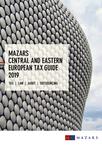Mazars Central & Eastern European Tax Guide 2019
This year’s issue already covers 22 CEE countries. The primary aim of the publication is to allow for comparisons to be made between the fundamental factors of competitiveness in the region. What are these factors? They primarily include the extent of the taxes and contributions on employment, the rates and special features of turnover taxes, as well as the corporate income tax system. In this year’s publication, we prepared a separate table summarizing key characteristic
The above information will help investors interested in the region in gaining a comprehensive overview of the taxation conditions in the Central and Eastern European region. In addition, the textual summaries discussing the taxation of the individual countries also highlight the latest developments and trends characterizing the tax regime of the given country.

